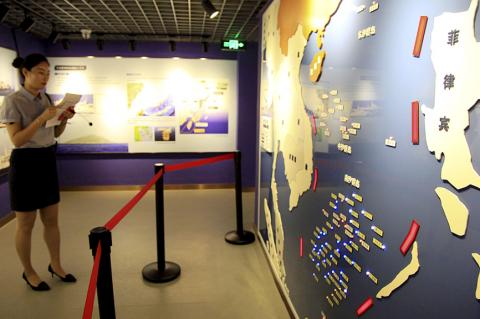President Tsai Ing-wen’s (蔡英文) administration has reached an internal resolution on Taiwan’s territorial claims over the South China Sea, which stresses the nation’s sovereignty over islands in the area, but makes no mention of the so-called “U-shaped line” and “historical waters,” a Presidential Office source said yesterday.
The government wants to differentiate Taiwan’s claims from China’s and avoid the impression that Taipei and Beijing have a unified stance on the issue, said the source, who asked not to be identified.
The U-shaped line — also known as the “11-dash line” — was featured in the “Location Map of the South China Sea Islands” drawn up by the Republic of China (ROC) government in 1947. After the Chinese Nationalist Party (KMT) lost the Chinese Civil War and fled to Taiwan, the Chinese Communist Party changed it to a “nine-dash line.”

Photo: Chinatopix via AP
After the Permanent Court of Arbitration in The Hague, Netherlands, on Tuesday ruled that Beijing’s claims of historical rights over the area based on its nine-dash line were invalid, the Ministry of the Interior and the Mainland Affairs Council issued statements stressing the ROC’s sovereignty over the South China Sea islands.
However, neither statement mentioned the U-shaped line or historical waters, although both referred to the map. That sparked speculation that the government has dropped the U-shaped line claim.
The source said the government’s position is clear: The ROC has sovereignty over South China Sea islands, including Itu Aba Island (Taiping Island, 太平島), and there is no need to mention the U-shaped line or historical waters to assert that position.
Another source said that when the map was drawn in 1947, it only marked the names and locations of the South China Sea islands and 11 demarcation lines, but terms like the “U-shaped line” or “11-dash line” did not exist then.
The demarcation lines were later referred to as the “11-dash line,” and after China proposed the “nine-dash line,” academics created the term U-shaped line to stress the similarity between Taiwan’s and China’s claims.
The term, like the so-called “1992 consensus,” was created and fashioned in retrospect, the source said.
A report by the US Department of State mapped the nine-dash line and 11-dash line and found that they represented different coordinates, suggesting they were different demarcation lines, the source said.
The Presidential Office source questioned the nature of the 11 demarcation lines on the map, saying there are no clear definitions on whether they represent national boundaries, island demarcation lines or historical territorial waters.
Neither the 11-dash line nor the U-shaped line is official terminology or a legal term, the source said.
When asked whether the Tsai administration has made it a policy not to mention the U-shaped line, Presidential Office spokesman Alex Huang (黃重諺) did not give a direct response at a routine news conference yesterday afternoon.
“The ROC government stands firm on its claim of sovereignty over islands in the South China Sea and their relevant waters, which are rightfully our rights in accordance with international law,” Huang said.
Huang said that all relevant documents, including those dating back to 1947, when the ROC government drew the map, show that the official name used is “islands in the South China Sea (南海諸島).”
Additional reporting by Stacy Hsu

SECURITY: As China is ‘reshaping’ Hong Kong’s population, Taiwan must raise the eligibility threshold for applications from Hong Kongers, Chiu Chui-cheng said When Hong Kong and Macau citizens apply for residency in Taiwan, it would be under a new category that includes a “national security observation period,” Mainland Affairs Council (MAC) Minister Chiu Chui-cheng (邱垂正) said yesterday. President William Lai (賴清德) on March 13 announced 17 strategies to counter China’s aggression toward Taiwan, including incorporating national security considerations into the review process for residency applications from Hong Kong and Macau citizens. The situation in Hong Kong is constantly changing, Chiu said to media yesterday on the sidelines of the Taipei Technology Run hosted by the Taipei Neihu Technology Park Development Association. With

CARROT AND STICK: While unrelenting in its military threats, China attracted nearly 40,000 Taiwanese to over 400 business events last year Nearly 40,000 Taiwanese last year joined industry events in China, such as conferences and trade fairs, supported by the Chinese government, a study showed yesterday, as Beijing ramps up a charm offensive toward Taipei alongside military pressure. China has long taken a carrot-and-stick approach to Taiwan, threatening it with the prospect of military action while reaching out to those it believes are amenable to Beijing’s point of view. Taiwanese security officials are wary of what they see as Beijing’s influence campaigns to sway public opinion after Taipei and Beijing gradually resumed travel links halted by the COVID-19 pandemic, but the scale of

A US Marine Corps regiment equipped with Naval Strike Missiles (NSM) is set to participate in the upcoming Balikatan 25 exercise in the Luzon Strait, marking the system’s first-ever deployment in the Philippines. US and Philippine officials have separately confirmed that the Navy Marine Expeditionary Ship Interdiction System (NMESIS) — the mobile launch platform for the Naval Strike Missile — would take part in the joint exercise. The missiles are being deployed to “a strategic first island chain chokepoint” in the waters between Taiwan proper and the Philippines, US-based Naval News reported. “The Luzon Strait and Bashi Channel represent a critical access

Pope Francis is be laid to rest on Saturday after lying in state for three days in St Peter’s Basilica, where the faithful are expected to flock to pay their respects to history’s first Latin American pontiff. The cardinals met yesterday in the Vatican’s synod hall to chart the next steps before a conclave begins to choose Francis’ successor, as condolences poured in from around the world. According to current norms, the conclave must begin between May 5 and 10. The cardinals set the funeral for Saturday at 10am in St Peter’s Square, to be celebrated by the dean of the College